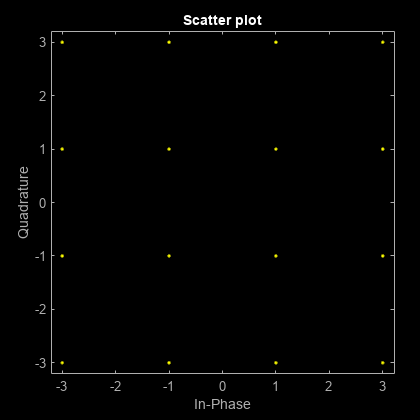comm.RectangularQAMTCMModulator
Encode binary data using convolutional encoder and map result to rectangular QAM constellation
Description
The comm.RectangularQAMTCMModulator
System object™ implements trellis-coded modulation (TCM) by encoding the binary input signal
using a convolutional code and by mapping the result to a rectangular quadrature amplitude
modulation (QAM) signal constellation. For more information about TCM, see the Algorithms
section.
To encode binary data using a convolutional code and map the result to a rectangular QAM constellation:
Create the
comm.RectangularQAMTCMModulatorobject and set its properties.Call the object with arguments, as if it were a function.
To learn more about how System objects work, see What Are System Objects?
Creation
Syntax
Description
qamtcmMod = comm.RectangularQAMTCMModulatorqamtcmMod. This object employs a convolutional encoder
to encode a binary input signal and maps the result to a rectangular QAM
constellation.
qamtcmMod = comm.RectangularQAMTCMModulator(trellis)TrellisStructure property to
trellis.
qamtcmMod = comm.RectangularQAMTCMModulator(___,Name=Value)comm.RectangularQAMTCMModulator(ModulationOrder=8) sets the number of
points in the signal constellation to 8.
Properties
Usage
Description
Input Arguments
Output Arguments
Object Functions
To use an object function, specify the
System object as the first input argument. For
example, to release system resources of a System object named obj, use
this syntax:
release(obj)
Examples
Algorithms
The trellis-coded rectangular QAM modulation uses a set partitioning technique to map the result of the convolutional encoder to a rectangular QAM signal constellation. The trellis-coded modulation technique partitions the constellation into subsets called cosets to maximize the minimum distance between pairs of points in each coset.
These figures show the labeled set-partitioned signal constellation that the object uses when the M-ary number is 16, 32, or 64.



References
[1] Biglieri, E., D. Divsalar, P.J. McLane, and M.K. Simon. Introduction to Trellis-Coded Modulation with Applications. New York: Macmillan, 1991.
[2] Proakis, John G. Digital Communications. 4th ed. New York: McGraw Hill, 2001.
[3] Ungerboeck, G. “Channel Coding with Multilevel/Phase Signals.” IEEE® Transactions on Information Theory IT28 (Jan. 1982): 55–67.
Extended Capabilities
Version History
Introduced in R2012a
